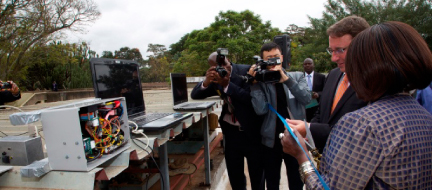

04/08/2016
 |
| UNEP Executive Director, Achim Steiner and Kenya’s Cabinet Secretary for Environment, Prof. Judi Wakhungu launch the pilot air quality monitoring system |
The device, capable of collecting all the vital parameters of air quality costing around $1,500/unit allows governments to establish a countrywide network of mobile and stationary air monitoring stations for as little as $150,000 - 200,000. Currently, roughly the same amount of money is necessary to set up just one monitoring station.
UNEP plans to make the blueprints of its device publically available in order to for governments and organizations to assemble or fabricate the units themselves, creating opportunities for innovation, enterprise development and green job creation.
UNEP Executive Director, Achim Steiner said, “Each year, air pollution causes 7 million wholly preventable premature deaths around the world, with outdoor pollution responsible for more than half of that total. Among of those, 88% of deaths related to outdoor pollution occur in low- and middle-income countries. However, it is these same developing countries that typically lack access to data on their air quality. UNEP’s device can build a bid data to help countries reduce the negative effects of air pollution, potentially saving lives that would have been lost due to air pollution related illnesses.”
Currently, the UNEP Live platform enables near real-time monitoring of air quality from 2000 stations across the world. However, only few of those are located in developing countries and their setup and calibration varies. The new device can successfully bridge this data gap and contribute to standardization of data collection. For example, one of pilots is conducted in Kenya’s capital before spreading in other parts of the country to build air map of pollution hotspots in the urban and rural areas.
UNEP’s device can measure the concentration of particulate matter ranging from 1 - 10 µm (PM 1 - PM 10), including PM 2.5, considered by the WHO to have the greatest effect on human health. It also records the concentration of sulphur and nitrogen oxides and can be extended to measure other gases such as ozone. Therefore, this equiment is promising helpful in monitoring air concentration in particular places such as Africa, where poor air quality is mainly due to high levels of particulate matter containing hazardous airborne chemicals as results of fuel combustion, both from vehicles and stationary sources such as power plants, industry and households.
Futhermore, the unit was designed for affordability throughout its lifecycle, with less frequent calibration required and a durability of up to 4 years. High quality has been ensured through rigorous testing in various settings, and a built-in GPS system means that the device can also be used as a mobile unit.
With those high performances as above, the device’s low cost and ease of use can also boost community participation in environmental and health monitoring, and increase digital and technological literacy through the participation of schools■
Thanh Liêm